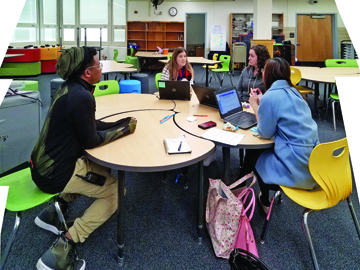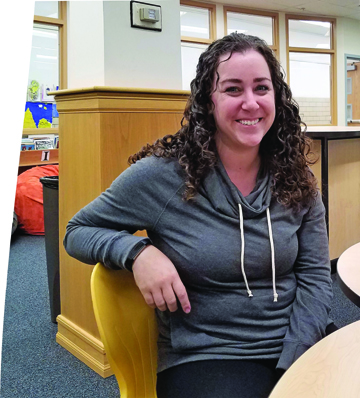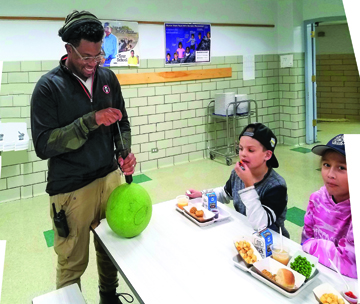
Team Meeting: In the library, Principal Sheldon Reynolds, Meg Emrick, Sarah Ronoh and a representative from DPS’s Imaginarium plan how they will measure and observe the process called Distributive Learning, where students own their learning process. As a perfect example of Distributive Leadership, Reynolds says little, giving Emrick and Ronoh space to guide the discussion.
by Ruthy Wexler
When in December 2017, Principal Sheldon Reynolds heard that Greenlee Elementary, the school he’d been reviving for just 18 months, might be closed — over test scores that hadn’t climbed fast enough — he was not happy. How Reynolds turned this scenario around — reinventing the school according to Denver Public School’s (DPS) requirements, then transforming it according it to his original vision so successfully that families outside the neighborhood now choose it — is a balancing act worth studying. How did he succeed where so many have failed? And what is the recipe, so others can follow?
It Ain’t Me, Babe
Asking Reynolds those questions will not get a straight answer.
Praised for the happily humming classrooms at what is now Center for Talent Development at Greenlee (CTD), Reynolds says, “It’s not me. It’s the teachers doing that.”
Asked the secret of putting a failing school on the road to success, Reynolds says, “When I came, there was a ton of talent already here. We just identified those talents.”
This was Reynolds’ original vision: seeing an underperforming school as filled with “gifts and talents.” What’s new is what he’s done with that vision.
Introspection
“When DPS slated Greenlee for closure, I thought it was the worst thing ever,” Reynolds recalls. “But it ended up being the best thing. Because it made us come up with our model.”
Reynolds did “a lot of soul searching” before he wrote a plan that would get him back in charge of Greenlee. He’d given it his best shot. What was missing? Brainstorming with staff, the model that finally was

Learn from the Best: Sarah Ronoh is both a parent and staff member at CTD. “We’re all in a constant state of learning,” says Ronoh, whose job it is to study the “best practices” teachers come up with and share what works. A teacher, Ronoh wanted to go into administration and asked Reynolds for a job, so she would work with him and learn leadership “from the best.”
one that fleshed out the “gifted and talented” vision with lots of structure.
“The idea,” says Reynolds now, “is only as good as how you implement that idea.”
Use Every Resource
Once CTD was a go, Reynolds reached out to departments inside DPS — like Tiered Support, which agreed to grant money; Gifted and Talented and the Imaginarium. Soon, a partnership was formed.
“Those departments all got together,” recalls Sarah Ronoh, a Greenlee parent who became CDT’s Innovation and Implementation Partner, “and said [to Reynolds], ‘Hey! We’re super curious about what you are doing. We want to study it!”
Ronoh now works with those departments to observe the changes staff puts in place and measure the results.
Freedom And Trust
Meg Emrick, who’d been teaching at Greenlee for five years when Reynolds arrived, already thought the kids had “terrific talents. Sheldon gave us the freedom to figure out how to make those talents come alive.
“We were encouraged to take risks. To think outside the box. Sheldon trusted us. That freedom and trust made us feel valued and needed,” concludes Emrick, who went from classroom teacher to Senior Team Lead to her present position as Dean of Instruction — a “perfect example,” says Reynolds, of “tapping staff talent and watching them grow.”
Research
A little while back, Reynolds told every teacher, “The first 15 m

Enthusiastic: While on lunch duty, Principal Sheldon Reynolds helps a boy put air into his ball. It’s a telling image. The phenomenon of how Reynolds manages to enroll an entire school in his vision, get students and staff to work harder and more enthusiastically than ever before — all the while empowering others and claiming less power for himself — is the heart of CTD’s success.
inutes of every day, I want you to teach your students how to use tools here in the school.”
“That’s all he said,” notes Ronoh, who for “weeks and weeks, went to each classroom and wrote down what each teacher did with this assignment. Then Sheldon and I got together, looked at what got that idea of tools across — then shared it out to staff.”
Reynolds points to three banners: Use Tools Strategically. Construct Informed Arguments. Connect Learning. “These are the habits we want for our kids. We are learning about learning. We’ve just scratched the surface.
“Now we are taking time to measure how well [new ideas] work.
“Design research … another shift for me. Before, I would roll an idea out to the whole staff. Now, I have a couple of things cookin’ in the lab, people working on them. When we finally roll ‘em out, I’ve already had user feedback.”
Leadership
“Sheldon doesn’t stand up there and tell us what to do,” Ronoh observes. “He says his vision. Then he distributes leadership. He completely trusts me to do what I do, completely trusts Meg …”
That works so well that “Sheldon can leave the building, for a day, a week, however long he needs, and things will still be up and running.”
What makes him that kind of leader?
“He has somehow,” Ronoh says, “gotten to this place where he knows empowering people, having faith in them, brings out the best.”
“How did you get to that place?” a visitor asks Reynolds.
After he lists a bunch of influences, Reynolds says, “Basically, it boils down to, most situations are what they are. The only things you can control is how you react. Which is why I push … my teachers and students to recognize they have agency in almost every situation.”
Success
The 2017-2018 test scores showed that this school — classified by DPS as “red” (failing) for years before Reynolds came — turned “green” (meets expectations) on their academic gaps indicator and are “green” in almost every growth indicator.
Reynolds points to all the help he’s received. As an Innovation School, CTD is free to experiment. Tiered Support gives extra money.
“The vision is starting to become the reality,” he admits. “It’s a good place to work now.”
They are studying how CTD got to this outcome, Ronoh says, “so hopefully, they can duplicate it somewhere else.”
“Research. Distributive Leadership. We have to figure out all the components. But what we really need to do is clone Sheldon.”
